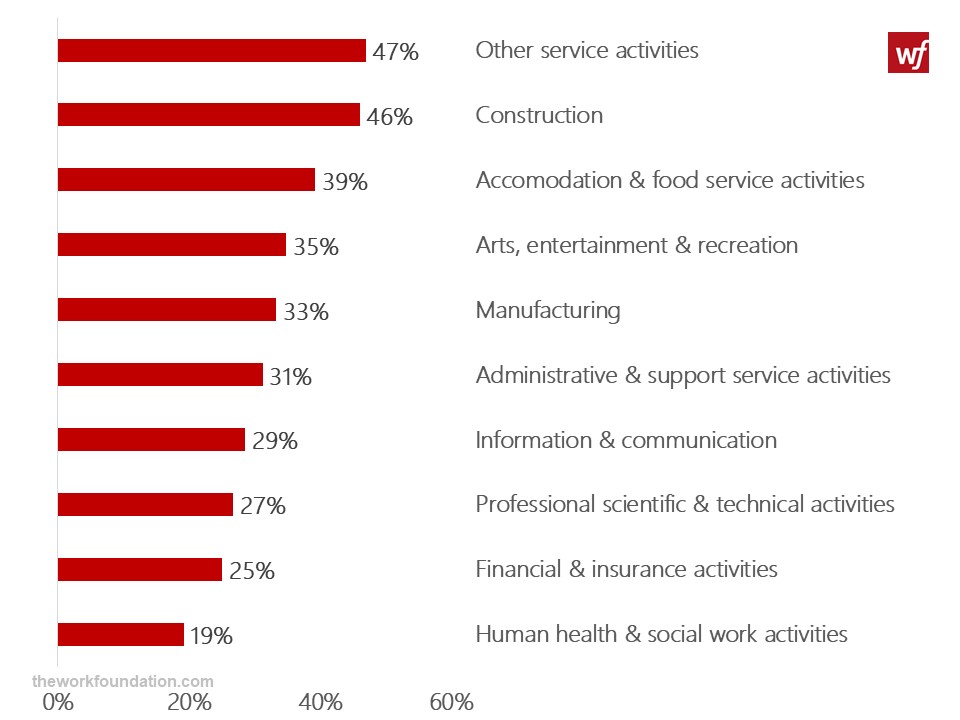Think Tanks
|
|
Work Foundation - With vacancies at a record high, Government must focus on improving job quality and skills
This month’s labour market statistics present a broadly positive picture, with unemployment falling, an increasing number of young people finding work, and vacancies at a record high. However, potential mismatches between labour supply and demand signal there are still challenges ahead, particularly for those workers who have been out of work since the start of the pandemic.
Although workers unemployed for a short time are moving back into work, the long-term unemployed face specific challenges
The labour market continues to recover, with the number of payroll employees increasing by 182,000 to 28.9 million in in the month of July 2021. This however still falls 201,000 short of pre-pandemic levels. It is particularly positive to see 50,000 more young people (aged 18-24) in work this quarter, as this group had been among the hardest-hit by job losses during the pandemic.
Many people who experienced short-term unemployment during the pandemic seem to be successfully re-entering the labour market or moving into education, as the number of people out of work for up to 6 months fell by 54,000 on the quarter. But the outlook for those who are unemployed for a longer period of time appears more mixed. Although the number of workers who were unemployed for 6-12 months fell by 43,000, it is likely that the majority of this group have now moved into long-term unemployment, given that the number of people unemployed for more than 12 months rose by 40,000 on the quarter. This is concerning, as the longer people remain out of work, the higher the risk their skills become outdated or even obsolete. This, coupled with employers assessing prospective employees on their job histories and the negative signals attached to periods of unemployment, will make it harder for these workers to re-enter the jobs market.
Vacancies are at record high, but will this translate into good jobs?
There was a record high of 953,000 vacancies over May-July, which is an increase of 290,000 on the quarter and 168,000 more vacancies than the pre-pandemic level. These are encouraging signs, but it remains unclear how well-matched jobseekers are to these vacancies and how many of these openings will ultimately translate into jobs. In this context, there is a risk that jobcentres and public opinion will focus on the availability of job listings, rather than on the quality or suitability of these options for workers, which has been shown to lead to sub-par outcomes for workers as well as employers.
Fig 1: The ten industries seeing the greatest increase in vacancies in May-July 2021 compared to pre-pandemic levels

Source: Work Foundation calculations using ONS Dataset A01: Vacancies by industry (seasonally adjusted). 17 August 2021
Despite this boom in vacancies, there are signs that employers are cautious about the future, which is reflected in the increased use of temporary workers. The number of temporary workers increased by 64,000 this quarter, bringing the total to 1.6 million. This is 100,000 (7.9%) more than pre-pandemic levels.
We saw a similar expansion in the use of this form of flexible labour in the wake of the financial crisis, and evidence suggests these jobs may be of lower quality, provide less access to training and development and lower the likelihood that an individual will obtain permanent work. It is therefore important that government balances businesses’ pandemic-related need for flexibility, with the need for a longer-term strategy to stimulate the growth of secure, good quality jobs.
Going forward, a proactive approach to skills development and improving job quality is needed
It is important to highlight that the impact of the pandemic won’t be over when furlough ends in September. We have seen structural changes to the labour market which will continue to play out over the next few years, and it is likely that those in low paid and more insecure forms of work will be the most affected. Therefore, Government needs to be proactive in ensuring that there’s good, secure and well-paid jobs for those re-entering the labour market now and over the period ahead, and that these workers have the right skills and support in place to succeed.
The Lifetime Skills Guarantee (LSG), which launched in April of this year, is a step in the right direction, however previous Work Foundation research identified that 1.4 million workers in the middle of their working lives in routine or manual occupations are currently ineligible for the scheme. Furthermore, welfare conditionality acts as a barrier to training, with many receiving Universal Credit or other benefits expected to focus their time on job search rather than upskilling. A new pilot has been introduced to address this, allowing UC claimants to take part in training for up to 12 weeks.
Therefore, Government should review eligibility for the LSG to maximise participation, and adjust requirements to ensure individuals who want to access training to move back in to work are supported to do so.
The planned Employment Bill presents an opportunity to stem the tide of insecure work in the UK, ensuring that workers on low incomes or atypical contracts who have faced the greatest risks through the pandemic have access to improved rights and protections. For example, this new legislation could allow agency workers and those on temporary or zero hour contracts the right to request a contract which guarantees hours that better reflect those actually worked.
.gif)

